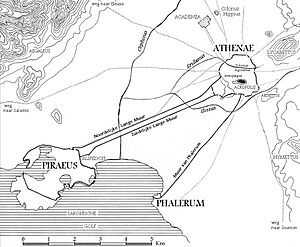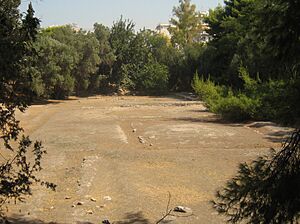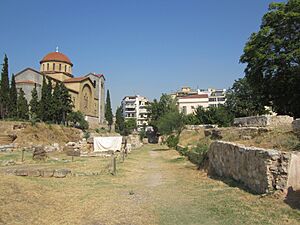Platonic Academy facts for kids
The Academy was a famous school started by the ancient Greek philosopher Plato. He founded it around 387 BC in Athens, Greece. It was a special place where people could learn and discuss big ideas.
Many important thinkers studied at the Academy. One of the most famous was Aristotle, who learned there for twenty years. Later, Aristotle started his own school called the Lyceum. The Academy continued for a long time, teaching different ways of thinking. It eventually closed down around 83 BC. However, Plato's ideas were so strong that a new version of the Academy opened in 410 AD. This new school taught Neoplatonism until it was finally closed by Emperor Justinian I in 529 AD.
Contents
Where Was Plato's Academy Located?

Before it became a school, the area called Akademia was a sacred place. It had a beautiful grove of olive trees dedicated to Athena, the goddess of wisdom. This special spot was just outside the city walls of ancient Athens. The name Akademia comes from an old Athenian hero named Akademos.
The land was very important to the ancient Greeks. It was sacred to Athena and other gods. People believed it had been a religious site since the Bronze Age. Even the Spartans, who often attacked Athens, respected this area. They would not harm the olive groves when they invaded. However, a Roman general named Lucius Cornelius Sulla cut down these sacred trees in 86 BC to build war machines.
Many religious events took place at the Akademeia. These included a torch race at night and games for the dead. A special parade for the god Dionysus also went to and from the area. The road leading to the Akademeia was lined with the gravestones of Athenians.
Today, you can visit the archaeological site of the Academy. It is about 1.5 kilometers north of Athens' old Dipylon gates. The site was rediscovered in the 20th century. It is located in the modern Akadimia Platonos neighborhood.
Exploring the Ancient Academy Site Today
Visitors can explore the ruins of the Academy on either side of Cratylus street. You can see important ancient buildings there. These include a Sacred House from the Geometric Era and a Gymnasium from the 1st century BC. There is also a very old Vaulted House, possibly from the time of the hero Akademos. The Peristyle Building, from the 4th century BC, might be the main building of Plato's actual Academy.
Plato's Famous School
Plato's school likely began as informal meetings. These gatherings started around the time Plato inherited some property when he was about thirty years old. Friends and other thinkers would meet to discuss ideas. Some important early members included Theaetetus and Eudoxus. Scholars believe the school officially started in the mid-380s BC. This was probably after Plato returned from a trip to Italy and Sicily. The meetings often took place at Plato's home or in the nearby Academy gymnasium.
The Academy was a private club, not open to everyone. But during Plato's time, it did not charge money to join. So, it wasn't a "school" like we think of today, with clear teachers and students. Instead, it was a place for shared learning. There were older, more experienced members and younger ones. We know that at least two women, Axiothea of Phlius and Lasthenia of Mantinea, studied with Plato there.
Plato's Academy did not teach one specific set of beliefs. Instead, Plato and his friends would suggest problems for everyone to study and solve. There were some lectures, like Plato's famous talk "On the Good." But using dialectic, which is a way of discussing ideas through questions and answers, was more common. An old story says that above the Academy's entrance, it read: "Let None But Geometers Enter Here." This means that mathematics was very important there.
People often think the Academy's lessons were like those described in Plato's book Republic. However, the Republic describes an ideal society, which might be different from the real school. Students almost certainly studied mathematics. They also discussed the philosophical topics found in Plato's writings. There is even evidence of scientific research. Plato asked members to find simple ways to explain the movements of planets in the sky.
Many people believe Plato's Academy trained future politicians. It certainly had many famous students. But it's hard to know exactly how much the Academy focused on practical politics. Much of what we know comes from ancient writings that either praised or criticized Plato.
The Academy Through the Years
The Academy changed over time. Historians often divide its history into three main periods: the Old, the Middle, and the New Academy.
The Old Academy: Plato's First Followers
Plato's first successors as head of the Academy were Speusippus (347–339 BC) and Xenocrates (339–314 BC). Other important members included Aristotle, Heraclides, and Eudoxus. These thinkers continued to develop Plato's ideas.
The Middle Academy: A Time of Questioning
Around 266 BC, Arcesilaus became the head of the Academy. Under his leadership, the school focused on Academic skepticism. This meant they questioned whether it was possible to know absolute truth. They believed it was important to doubt and explore different ideas.
The New Academy: More Skepticism
The New Academy began with Carneades in 155 BC. This period also largely focused on skepticism. They continued to argue that knowing absolute truth was very difficult. Philo of Larissa was one of the last leaders of this skeptical Academy. Around 90 BC, one of Philo's students, Antiochus of Ascalon, started teaching a different kind of Platonism. He rejected skepticism and began a new phase called Middle Platonism.
When the Academy Was Destroyed

In 88 BC, a war began, and Philo of Larissa left Athens for Rome. Then, in 86 BC, the Roman general Lucius Cornelius Sulla attacked Athens. He conquered the city and caused a lot of damage. During this attack, Sulla destroyed the Academy. He "laid waste to the Academy," which was a wooded area outside the city. He also destroyed the Lyceum.
The damage to the Academy was so bad that it could not be rebuilt or reopened. When Antiochus returned to Athens, he taught in a different place. The site of the Academy became quiet and deserted.
The Neoplatonic Academy: A New Beginning
Even after the original Academy was destroyed, philosophers continued to teach Plato's ideas in Athens. Then, around 410 AD, a new Academy was started by some leading Neoplatonists. These new teachers saw themselves as continuing Plato's tradition. However, there was no direct connection to the original school. This new Academy was likely a private school, run from a large house.
The Neoplatonic Academy became very important under a philosopher named Proclus (who died in 485 AD). Many of the philosophers in this later Academy came from different parts of the ancient world. This shows how widespread Greek culture was. Finally, in 529 AD, the Emperor Justinian I ordered the school to be closed. The last head of this Academy was Damascius.
Some historians think the Academy's ideas didn't completely disappear. Some of its members might have traveled to other places, like Harran. From there, their teachings could have influenced the Arabic world. This might have helped bring back Neoplatonist ideas in places like Baghdad much later.
See also
- Academy of Athens (modern)
- Hellenistic philosophy
- Platonism
- Peripatetic school
- Stoicism
- Epicureanism
- Neoplatonism



